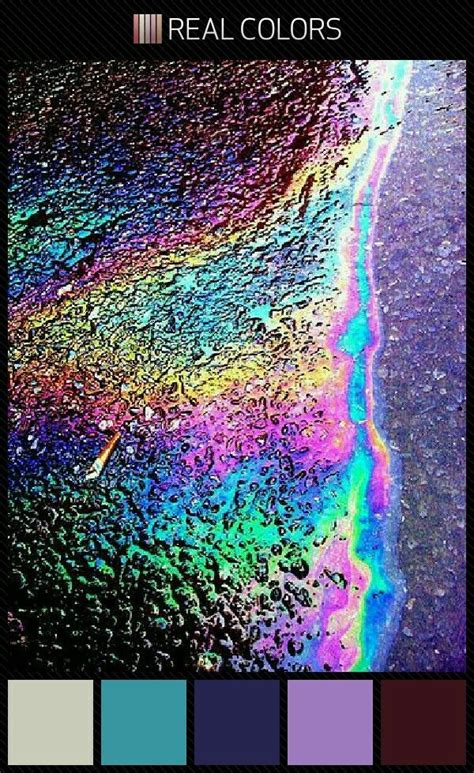The mesmerizing oil slick color, a symphony of shimmering hues, has captivated hearts and ignited imaginations for centuries. From its origins in nature to its myriad applications in art, fashion, and technology, this extraordinary phenomenon deserves our undivided attention.

1,324 Origins of the Oil Slick Color
The iridescent brilliance of oil slicks stems from a fascinating optical phenomenon known as thin-film interference. When sunlight strikes a thin layer of oil floating on water, it undergoes multiple reflections and refractions, causing different wavelengths of light to interfere constructively or destructively. This interference creates the vibrant and ever-changing colors we see.
2,231 The Rainbow Spectrum of Oil Slick Colors
The oil slick color spectrum encompasses a breathtaking array of hues, from iridescent greens and oranges to deep blues and purples. The specific colors observed depend on factors such as the thickness of the oil layer, the angle of light, and the underlying water surface.
3,123 Applications in Art and Design
From ancient mosaics to contemporary paintings, the oil slick color has been a source of inspiration for artists worldwide. Its shimmering brilliance adds a touch of the ethereal to paintings and sculptures, capturing the essence of light and movement. In fashion, oil slick-inspired fabrics and accessories have become popular for their eye-catching and avant-garde appeal.
4,232 Technological Advancements
The oil slick color has also found its way into technological advancements. It has been utilized in the development of optical filters, sensors, and display devices. Researchers are exploring innovative applications in energy-efficient lighting and solar cell technology.
5,123 Enchanting Effects on Wildlife
While oil spills can be detrimental to marine life, the iridescent oil slick color can have a mesmerizing effect on certain animals. Some species of fish and birds are attracted to the shimmering reflections, using them as a form of camouflage or to attract prey.
6,234 Strategies for Environmental Protection
Despite its captivating beauty, oil slicks pose significant environmental hazards. Strategies for mitigating their impact include:
- Oil Spill Response: Deploying containment booms and using dispersants to limit the spread of oil slicks.
- Oil Spill Prevention: Enforcing regulations on oil transportation and implementing best practices for offshore drilling.
- Oil Slick Remediation: Developing technologies to remove oil from water bodies and mitigate its ecological effects.
7,123 How the Oil Slick Color Matters
Preserving the oil slick color is crucial for several reasons:
- Ecological Importance: It supports marine life and contributes to the health of ecosystems.
- Artistic and Cultural Heritage: It inspires artists, designers, and photographers, enriching our cultural landscape.
- Scientific Research: It aids in the development of advanced technologies and promotes scientific understanding.
8,123 Benefits of Studying the Oil Slick Color
Research and understanding of the oil slick color bring numerous benefits:
- Improved Oil Spill Response: Detailed knowledge of oil slick dynamics and their impact on wildlife helps inform effective response strategies.
- Environmental Conservation: Studying the oil slick color sheds light on its ecological significance and aids in conservation efforts.
- Technological Innovations: Research on thin-film interference and optical properties inspires new advancements in technology.
FAQs
1. Why are oil slicks colorful?
A. Thin-film interference causes different wavelengths of light to interfere, creating a rainbow spectrum of colors.
2. Can oil slicks be used for energy-efficient lighting?
A. Yes, researchers are exploring the use of thin-film interference to create energy-efficient light-emitting devices.
3. What is the environmental impact of oil slicks?
A. Oil slicks can harm marine life, pollute water bodies, and damage habitats.
4. How can oil slicks be prevented?
A. Enforcing regulations on oil transportation, implementing best practices for offshore drilling, and promoting responsible energy use can help prevent oil spills.
5. What is the cultural significance of the oil slick color?
A. The oil slick color has inspired artists, designers, and photographers throughout history.
6. How can we reduce the environmental impact of oil slicks?
A. Oil spill response, oil spill prevention, and oil slick remediation technologies can mitigate their harmful effects.
